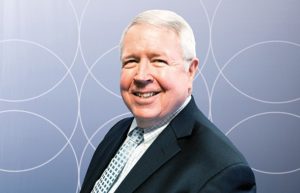Our Future is Bright
 Last month’s President’s message outlined changes to specialty status that can negatively affect the practice of endodontics. This month, I would like to present a more positive perspective, my belief that the future of endodontics looks great. I say this from a view of 34-plus years as a member of the AAE. When I was applying for residency, I was advised that endodontics was a dying specialty. I must admit that no endodontists told me that, but it has been a background sentiment as long as I have been associated with the specialty. Over that time endodontics has done quite well and continues to be a major factor in improving the health of our patient population.
Last month’s President’s message outlined changes to specialty status that can negatively affect the practice of endodontics. This month, I would like to present a more positive perspective, my belief that the future of endodontics looks great. I say this from a view of 34-plus years as a member of the AAE. When I was applying for residency, I was advised that endodontics was a dying specialty. I must admit that no endodontists told me that, but it has been a background sentiment as long as I have been associated with the specialty. Over that time endodontics has done quite well and continues to be a major factor in improving the health of our patient population.
We are now the specialty associated with saving teeth and have been advocating for years that patients should retain their natural dentition for as long as they can. We can provide root canal therapy faster, better and with greater comfort because the equipment, clinical techniques and materials have improved tremendously (does anyone remember micro burs for root end preps?). The resulting raise in the cost of doing business has been a burden, but one not easily shouldered by non-endodontists. Root canal therapy has become more complex, demanding and difficult over the years to the point where the non-endodontists can’t keep up. That puts us farther out ahead in delivering care in an efficient, successful manner.
I think that there is a consensus that we cannot do all of the root canals out there, but we should be doing the difficult, complex cases. Let’s train non-endodontists and dental students to do the routine, straightforward endodontics if they wish, but also teach them to refer the rest to a specialist and let us sweat the difficult cases. Certainly do not condone the extraction of teeth because it would be “easier.”
In August, I attended the APICES meeting in Chicago and was much impressed with what I saw of the future leaders of our specialty. The meeting is designed and run by residents and the RNPC (Resident and New Practitioner Committee) with great support from AAE Headquarters staff. The meeting was terrific. Three hundred residents got to hear great speakers on the latest in clinical techniques, equipment, materials and practice management. The biggest complaint I heard was that non-member residents had difficulty signing up. Please take note, program directors: advise your new residents to join the AAE when coming in as we have a lot to offer! We continue to scale up the attendance capacity (50% increase over the last two years) and will make it better and better as we go forward. Judging by what I saw in the lectures, in the exhibit spaces and at social gatherings, the current residents will be coming into the workforce much better prepared than my cohort.
My admonition to current residents is to keep moving forward. Let’s make endodontics better and position the specialty well for next 10, 20, 30 years. I hope that in 2051 there will be better tools that make today’s techniques seem as outdated as micro head handpieces; and endodontists are still the go-to specialists for saving teeth.
Lastly, a message to all AAE members: in the spirit of looking ahead, I want to make mention of a couple of very important educational events on the horizon. They are our upcoming Insight Track Workshops: 1) Surgery Workshop, held Nov. 2-5, 2018, in Chicago (attendees have a choice between either Nov. 2-3, or 4-5), and 2) Cone Beam Computed Tomography, occurring Jan. 24-26, 2019, in Lake Tahoe, Calif. — a perfect opportunity to combine learning with vacation, even if you don’t ski! Space for both Insight Track programs is very limited, so be sure to register before these events sell out.




